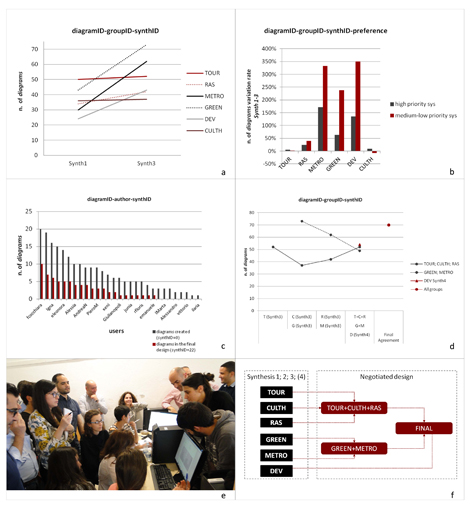
Toward a Geodesign Process Analytics
Abstract
Complexity in current spatial planning practice is mainly linked to the multi-dimensional context characterizing its processes. Recent advances in design methodologies and digital techniques promise unprecedented opportunities not only for managing multiple issues and actors, but also for tracking the evolution of the design options toward the final plan. In this context, the paper explores the potential offered by the collaborative Planning Support System Geodesignhub to record the process workflow and open new path to the design dynamics understanding. We will present the first research efforts toward the development of a geodesign process analytical framework taking account of both theories and cases studies.
Keywords
Full Text:
PDFReferences
Campagna, M. (2014). Geodesign from Theory to Practice: From Metaplanning to 2nd Generation of Planning Support Systems. Tema. Journal of Land Use, Mobility and Environment, Special Issue, 211-221.
Campagna, M. (2016). Metaplanning: About designing the Geodesign process. Landscape and Urban Planning, 156, 118–128.
Campagna, M., Di Cesare, E. A., Matta. A., & Serra, M. (2018). New methods for the contemporary planning practice: from Geodesign to Planning Support Systems. International Journal of e-Planning Research, 7 (1), 34-52.
Campagna, M., Moura, A. C., Borges, J. & Cocco, C. (2016a) Future Scenarios for the Pampulha Region: a Geodesign Workshop. Journal of Digital Landscape Architecture, 1-2016. Herbert Wichmann Verlag, VDE VERLAG GMBH, Berlin/Offenbach. ISBN 978-3-87907-612-3, ISSN 2367-4253, doi:10.14627/537612033.
Campagna, M., Steinitz. C., Di Cesare, E. A., Cocco, C., Ballal, H., & Canfield, T. (2016b). Collaboration in planning: the Geodesign approach. Rozwój Regionalny i Polityka RegionalnaI, 35, 27–43.
COWI. (2009). Study concerning the report on the application and effectiveness of the SEA Directive (2001/42/EC). European Commission, DG ENV.
Fischer, T. (2007). Theory and practice of Strategic Environmental Assessment. London: Eathscan.
Fischer, T. (2010). Reviewing the quality of strategic environmental assessment reports for English spatial plan core strategies. Environmental Impact Assessment Review, 1 (30), 62-69.
Freitas, C. R., & Moura A. C. M. (2017). Diagram Analysis: favouring negotiations in geodesign workshops. Using ETL tools to identify topological similarity and positional similarity. Presented at the Conference Geodesign South America 2017 Strategic Planning for Alternative Futures, Belo Horizonte, Brazil.
Friedmann, J. (1981). Planning as Social Learning. UC Berkeley: Institute of Urban and Regional Development.
Forester, J. (1989). Planning in the face of power. Berkeley: University of California Press.
Geertman, S., & Stillwell, J. (2004). Planning support systems: An inventory of current practice. Computers, Environment and Urban Systems, 28(4), 291–310.
Harris, B. (1989). Beyond Geographic Information Systems: computer and the planning professionals. Journal of American Planning Association, 55(1), 85–90.
Jankowski, P., Nyerges, T. (2001). Geographic Information Systems for Group Decision Making. London, New York: Taylor and Francis.
Jones, J.C. (1980). Design methods. Seeds of human futures. Chichester: John Wiley & Sons Ltd.
Lee, D., Dias, E., Scholten, H. (Eds.). (2014). Geodesign by Integrating Design and Geospatial Sciences. London: Springer.
McElvaney, S. (2012). Geodesign: Case Studies in Regional and Urban Planning. Redlands: ERI Press. Parker, J. (2007), Strategic Environmental Assessment and SFs Operational Programmes: An assessment. DG Environment European Commission presentation at the Aarhus Workshop on Public Participation in Strategic Decision-Making (PPSD), 03-04.12.07 Sofia, Bulgaria.
Rivero, R., Smith, A., Ballal, H., & Steinitz, C. (2015). Promoting Collaborative Geodesign in a Multidisciplinary and Multiscale Environment: Coastal Georgia 2050, USA. In E. Buhmann, E. S., & M. Pietsch, Peer Reviewed Proceedings of Digital Landscape Architecture 2015, 42-58. Berlin: Herbert Wichmann Verlag.
Rowe, P. G. (1987). Design Thinking. Cambridge MA: The MIT Press.
Schutz, A. (1972). Collected Papers 1. The Problem of Social Reality. H.L. van Breda M. A. Natanson (Eds). Dordrecht: Springer Netherlands.
Steinitz, C. (2012). A Framework for Geodesign: Changing Geography by Design. Redlands: Esri Press.
Stokols, D., Taylor, B., Hall, K., & Moser, R. (2006, October). The science of team science: An overview of the field. Paper presented at the National Cancer Institute conference on the Science of Team Evaluation, Bethesda, MD. Presentation slides retrieved December 10, 2007, from http://dccps.nci.nih.gov/BRP/scienceteam/Team_Science_Overview_Stokols_etal.pdf.
UN, United Nations. (1992). Results of the World Conference on Environmetal And Development: Agenda 21. UNCED, Rio de Janeiro. New York: United Nations, A/CONF.151/26.
UNGA, United Nations General Assembly. (1992). Rio Declaration on Environmental And Development (The Earth Charter). Report of the UN Conference on Environmental And Development. Rio de Janeiro: A/CONF.151/26.
Van Der Hoeven, F., Nijhuis, S. & Zlatanova, S. (Eds.). (2016). Geo-Design: Advances in Bridging Geo-Information Technology, Urban Planning and Landscape Architecture. Delft: TU Delft.
Zyngier, C. M., Casagrande, P. B., Moura, A. C. M., & Ribeiro, S. R. (2017). O Geodesign como plataforma para co-design: Estudo de Caso Maria Tereza. XXI Congreso Internacional de la Sociedad Iberoamericana de Gráfica Digital, 2017, Concepción. Blucher Design Proceedings, 3, 403-409.
Refbacks
- There are currently no refbacks.
Copyright (c) 2018 Chiara Cocco, Michele Campagna
DISEGNARECON
ISSN 1828 5961
Registration at L'Aquila Law Court no 3/15 on 29th June, 2015.
Indexed in SCOPUS. Diamond Open Access. All papers are subjected to double blind peer review process by qualified reviewers.
Journal founded by Roberto Mingucci
